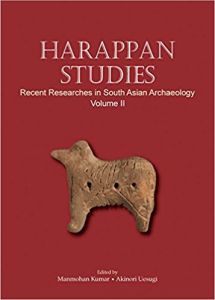
Contents: 1. Monsoon and urbanisation in India and in different regions of Asia/K.N. Dikshit. 2. Archaeology of the Ganga plains: new dimensions/B.R. Mani. 3. Geometric tools and mid-holocene cultural diversity in North Gujarat/Charusmita S. Gadekar and P. Ajithprasad. 4. Pre-Harappan culture of Ghaggar basin: recent perspective/Vivek Dangi and Manmohan Kumar. 5. Lead Isotope analyses of Harappan Silver Ornaments from Kunal/Vivek Dangi, Randall Law and Virginie Renson. 6. Obsequies archaeology of the Harappans at Rakhigarhi: some literary corroboration/Amarendra Nath. 7. Harappan impact on the Chalcolithic cultures of central India: new evidence from Balathal/Vasant Shinde. 8. Mature Harappan lithic objects at Farmana, Rohtak (Haryana)/Endo Hitoshi. 9. Roots of Sorath Harappans: a study based on the re-analysis of ceramics from Padri and its surroundings in Gujarat, Western India/Rajesh S.V. and K. Krishnan. 10. Protohistoric archaeological investigation in the lower Sahibi Basin/Rajesh Kumar. 11. A note on the recent archaeological exploration in Derabassi Tehsil, District Mohali, Punjab/Amrinder Singh and Samunder. 12. Explorations in Yamuna-Hindon Doab/Arun Singh and Vivek Dangi.
The present volume, the second in the series on Harappan Studies, incorporates twelve papers on various aspects of Harappan archaeology and allied fields. These papers range from Mesolithic to the historical periods based on archaeological excavations and explorations. The emphasis has not only been on the interpretation of new discoveries but also on the reinterpretation of the already known findings. The papers cover a wide spectrum, from monsoon and urbanisation in India to Harappan silver ornaments from Kunal; and from the obsequies archaeology of the Harappans at Rakhigarhi to the evidence from Balathal demonstrating Harappan impact on the chalcolithic cultures of Central India. No less interesting is the re-analysis of the ceramics from Padri in Gujarat.
In order to understand the historical significance of Harappan studies, a wider perspective, both in space and time is required. Thus, in addition to Harappan culture, the volume also incorporates contributions on related contemporary cultures which were either influenced or had an impact on the Harappans.
The contributors of the volume include a wide range of international and national experts as also young and budding scholars. The volume would be a useful reference for students and scholars of South Asian archaeology.